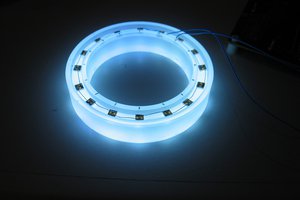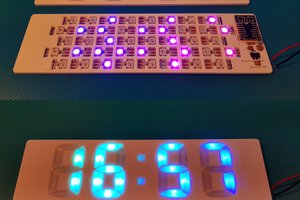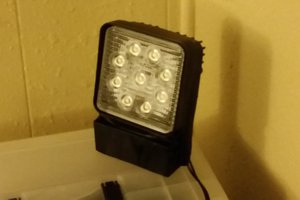The core of the project is a ATMega32u4 microcontroller, paired with a DS3231 RTC. Music / sound is provided by a DFPlayer Mini clone (for MP3 playback) and RDA5807 module (for FM radio). The display is a MAX2719 32x8 LED module. The light consists of three 1 meter long strips of white LEDs (one warm, one neutral, and one cool). When adjusting the light brightness from low to high, the warm lights are activated first, then the neutral, then the cool, to help the body adjust and not show too much blue light when you are trying to go to bed. The lights' brightness curves are exponential to account for the human eye's logarithmic response.
Although the electronics are what makes this light functional, the case is what makes it noteworthy. The frame is made of Santos Rosewood, with triple overlapping joints on the corners (see https://hackaday.io/project/168165/gallery#f79f2294bfb564508592bac90b661f6a), finished with shellac. The bottom panels are curly maple (the front is cut to about 0.5mm thick to allow the LEDs to shine through; the other sides are about 5mm thick). The maple is coated with Linseed oil to accentuate the figure of the wood grain, with a shellac french polish technique (hand rubbing multiple coats of shellac with oil) on top for the gloss look. The top panels are made from strips of maple with Japanese rice paper attached to the inside.
I have been using this clock daily for almost 2 years, and can say that it really helps, especially in the dark Canadian winters when the sun doesn't rise until after 9:00. I go to sleep with various nature sounds (waves, creeks, etc), and wake up on weekdays to light + FM radio. On weekends, the alarm is a bit later (although not too much, as I try to keep to a regular wakeup schedule), but instead of the radio I have soft instrumental music.
The clock supports three separate alarms, each of which can be set for a different time, different day(s) of the week, and each having different wakeup parameters (light brightness, sound source, sound volume, etc). Light and sound turn off automatically after 2 hours, which means you don't have to worry about forgetting to turn things off, whether it was activated manually when falling asleep or automatically via an alarm.
 The Big One
The Big One




 Alan Kilian
Alan Kilian
 Johan von Konow
Johan von Konow
 gannon
gannon
 davedarko
davedarko
Amazing Alarm clock to wake up for winter. I appreciate your work and creativity. Keep sharing.
Regards: https://www.rebounce.co/